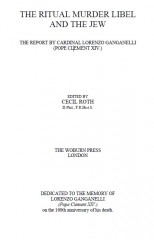
Author : Roth Cecil - Ganganelli Lorenzo
Title : The Ritual Murder Libel and the jew
Year : 1934
Link download : Roth_Cecil_-_The_Ritual_Murder_Libel_and_the_jew.zip
PREFACE. THE RITUAL MURDER LIBEL. ON Easter Eve, 1144, the dead body of a young skinner's-apprentice, named William, was found in a wood near Norwich. Modern enquirers, after careful examination of the facts, have concluded that the child probably lost consciousness in consequence of a cataleptic fit, and was buried prematurely by his relatives. It was bruited about, however, that in fact he was a victim of the Jews, who had enticed him away from his family and crucified him, after synagogue service on the second day of Passover, in mockery of the Passion of Jesus. In consequence, a wave of religious frenzy swept the city. The body was buried with all solemnity at the Cathedral, where miracles were said to be wrought at the graveside. That the Jews escaped massacre was mainly due to the cool-headedness of the Sheriff, who permitted them to seek refuge in the royal castle and (realising that in the prevailing state of public opinion impartiality was not to be expected) refused to allow judicial proceedings to be opened against them. However, long after they ventured out, they continued to be in danger, and at least one of the leading members of the community was murdered. For many years after, when the Jew had long been a stranger to England, the relics of William of Norwich were popularly venerated as those of a martyr.1 This was the first instance known to Western history of the infamous Ritual Murder Accusation, which has caused such untold misery to the Jewish people from that day to this.2 This absurdity, in its final development, is based upon the hypothesis that the Jews require and employ human blood for purposes 1 A. Jessop and M. R. James: The Life and Miracles of St. William of Norwich, by Thomas of Monmouth (Cambridge, 1896). 2 Socrates, the fifth-century ecclesiastical historian, reports something vaguely similar as having occurred at Inmestar, in Syria, about 415: while according to Josephus a similar libel was current at the time of Jesus with regard to the Temple worship. Anterior to the episode of William of Norwich, however, here is an apparent blank of 700 years. which stand in close relation to their ritual observances, more particularly in connexion with the Passover: and that, in order to obtain such blood, they do not scruple to commit murder. In most instances, the victim is said to be a Christian child—generally a boy. The example of mob-hysteria set at Norwich was followed at Gloucester in 1168, before it had time to be imitated outside England. Three years later, with the terrible tragedy of Blois and its ghastly toll of human lives, it obtained its first foothold on the Continent. Here it recurred thereafter with increasing frequency. Upwards of one hundred and fifty episodes of the sort are listed in the standard works of reference: yet these do not constitute, in all probability, more than a fraction of the whole. In almost every case the accusation has been followed by wholesale arrests, by spoliation, frequently by massacre. The advance of civilisation did not bring about the disappearance of the preposterous idea. The nineteenth century proved, in this respect, little less credulous than those which preceded it. This absurdity provided the spark which led to the outbreak at Yelisavetgrad, on April 27th 1881, of the wave of pogroms which stained the last years of the old Russian Empire, constituting one of the greatest tragedies of the sort in the recent history of the human race. The anti-Semitic movement owed its consolidation in the Dual Monarchy of Austria-Hungary to a revival which took place in the eighteen-eighties. In the five-year period between 1887 and 1891, at least twenty-two cases were more or less formally raised in Europe. An episode at Corfu in the last-named year (with a refinement of absurdity, the alleged victim in this case was a Jewess!) brought on an outbreak which caused the dispersal of the ancient community of that island; order being restored only on the arrival of a British flotilla, despatched at the request of the Consul General. In 1892, the charge was brought up by an irresponsible journalist in France. The year 1893 saw cases at Holleschau (Moravia) and at Rahova (Bulgaria), to mention only two out of many. There were causes célèbres, accompanied by judicial action (leading of course in every case to acquittal), at Tisza-Eszlar in Hungary (1882), Xanten on the Rhineland (1891) and Könitz in Prussia (1900). In 1911-13, Russia was convulsed by a similar process at Kiev. Thus the miserable record, with its trail of suffering, repeated itself year after year, notwithstanding the progress of civilisation, of science, and of humanity. Even to-day (it seems hardly credible in this enlightened age) the infection continues latent. Hardly a year passes but the loss or accidental death of some child leads to a recurrence of the libel, with more or less serious results, somewhere in Eastern Europe. A trial based upon it, in a slightly milder form, recently occupied, over a long period, the attention of the courts of justice in the new republic of Czecho-Slovakia. Only a year or two ago, the story was seriously revived in the course of an investigation by an ignorant police official in a provincial town in the United States: while in 1933 it was re-affirmed by means of anonymous leaflets in California. Even in England it has made its appearance in a literary form—on one occasion, owing to editorial carelessness, in the pages of one of the most widely read and highly respected quarterly reviews: on another, in an historical work which received the commendation of the Book Society on the one hand, and of the British Broadcasting Corporation on the other. ...

Demolins Edmond - Saint Louis
Auteur : Demolins Edmond Ouvrage : Saint Louis Année : 19881 Lien de téléchargement :...














